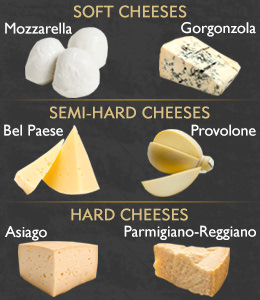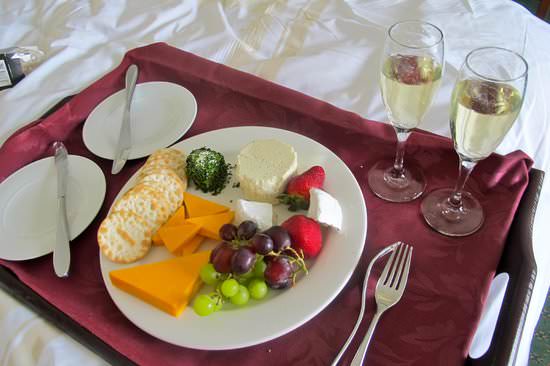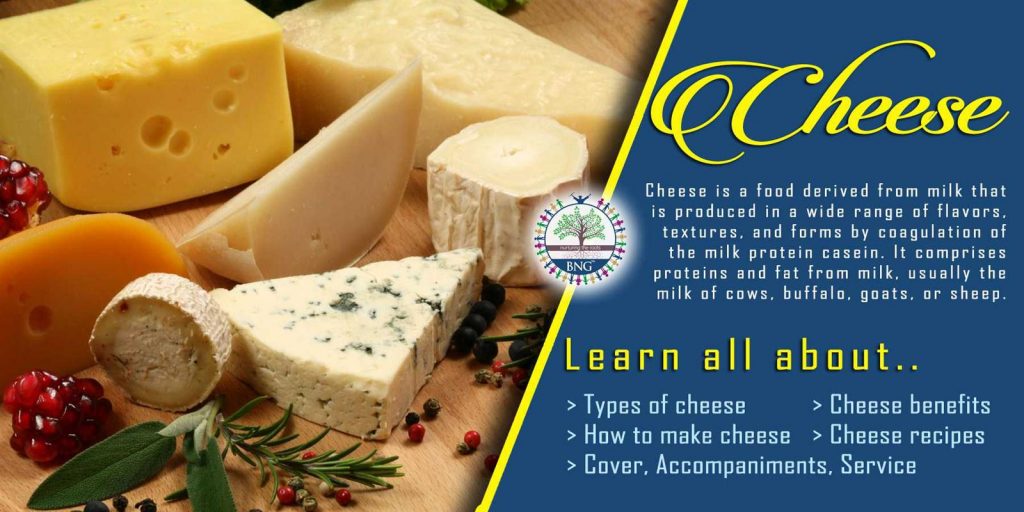Cheese – Types, Cover, Accompaniments and Service
Cheese are distinguished by flavour and categorized according to their texture. They differ from each other for a

number of reasons, mainly arising through variations in the making process. Differences occur in the rind and how it is formed, in the paste and in the cooking process, relating here to both time and temperature. Also cheeses vary because the milk used comes from such different animals as cows, sheep and goats.
Cheese should be stored in a cool, dark place with good air circulation or in a refrigerator. If it is not covered in its original wrapping, it should be wrapped in either cling film or aluminium foil to prevent any drying out taking place. It should also be stored away from food items that absorb flavours/odours, such as dairy produce.
Cheese – Types
Dependent upon use, cheeses may be purchased either whole or preportioned. Depending upon the type of establishment, the latter is more often the case as there is less wastage and no loss in quality, flavour or aroma.
- The texture of a cheese depends largely on the period of maturation. The recognized categories are:
- Fresh
- Soft
- Semi-hard
- Hard
- Blue
Fresh Cheese:-
- Cottage: unripened low-fat, skimmed milk cheese with a granular curd. Originated in the USA and now has many variations
- Cream: similar to cottage cheese but is made with full milk. There are a number of different varieties available, some made from non-cow milks
- Mozzarella: Italian cheese made now from cow’s milk but originally from buffalo milk
- Quark: continental version of cottage cheese, sharper and more acidic than the American versions. Mainly German and Austrian varieties available
- Ricotta: Italian cheese made from the whey of cow’s milk. A number of other Italian varieties are available made from sheep’s milk
Soft Cheese:-
- Bel Paese: this light and creamy Italian made has a name which means ‘beautiful 1 country’ and was first produced in 1929
- Brie: famous French made made since the eighth century. Other countries now make this style of cheese, distinguishing it by the country’s name, eg German brie
- Camembert: famous French made which is stronger and can be more pungent than
- Feta:- Greek cheeses made from both goat’s and sheep’s milk
- Munster: French Vosges cheeses similar to Camembert in shape but with an orange red rind. American, German and Swiss versions are also available
Semi-Hard Cheeses:-
- Cheddar: classic British cheeses now made all over the world and referred to as, for example, Scottish cheddar, Canadian cheddar
- Cheshire: crumbly, slightly salty cheese, available as either white or red. It was originally made during the twelfth century in Cheshire but is now made all over Britain
- Derby: English Derbyshire cheese now more often known by the sage-flavoured variety, Sage Derby
- Edam: similar to, but harder than, Gouda, this Dutch made has a fairly bland, buttery taste and a yellow or red wax coated rind. It is sometimes flavoured with cumin
- Emmenthal:- the name of this Swiss cheese refers to the Emme Valley. It is similar to Gruyere, although it is softer and slightly less tasty
- Gloucester/Double Gloucester: full-cream, classic English, originally made only from the milk of Gloucestershire cows
- Gouda: buttery textured, soft and mild flavoured well-known Dutch cheese with a yellow or red rind
- Gruyere:- mainly known as a Swiss cheese but both the French and Swiss varieties can legally be called by this name. It has small pea-size holes and a smooth relatively hard texture. The French varieties may have larger holes
- Leicester :- mild flavoured and orange coloured made in England
Hard Chese:-
- Parmesan: classic Italian hard cheese, more correctly called Parmigiano Reggiano, and predominantly known as the grated cheeses used in and for sprinkling over Italian dishes
- SPecorino: hard, sheep’s milk, grating or table cheeses from southern Italy. Also available with added peppercorns as Pecorino Pepato from Sicily
- Provolone: smoked cheese made in America, Australia and Italy. Now made from cow’s milk but originally from buffalo milk. Younger versions are softer and milder than the longer kept varieties
- Sapago: green coloured with an aroma of dried clover. It is a hard, grating-type cheeses from Switzerland
- Grana Padano:- It is a grainy texured from Italy made with cow milk.
Blue Cheese:-
- Bavarian Blue: rich, high-fat and sourish made in Germany
- Blue Shropshire: similar to Blue Cheshire but made in Scotland
- Danish Blue: one of the most well-known of the blue cheeses. Softish and mild flavoured, it was one of the first European blue cheeses to gain popularity in Britain
- Gorgonzola: softish, sharp flavoured, classic Italian cheeses with greenish veining, which is developed with the addition of mould culture
- Roquefort: classic, sheep’s milk cheeses from the southern Massif Central in France. The maturing takes place in caves which provide a unique humid environment which contributes to the development of the veining
- Stilton: famous and classic English cheeses made from cow’s milk; so called because it was noted as being sold in the Bell Inn at Stilton by travellers stopping there. According to legend it was first made by a Mrs Paulet of Melton Mowbray. Traditionally served by the spoonful but nowadays usually (and perhaps preferably) portioned. The pouring of port on to the top of a whole Stilton, once the top rind had been removed, was also popular but this practice is also on the decline. The White Stilton has also become popular and is slightly less flavoursome than the blue variety
Cover, Accompaniments, Service:-
The course is normally offered towards the end of a meal as an alternative to the sweet course. The cover to be laid is as follows:

- Side plate
- Side knife
- Sometimes a small fork (sweet)
In the service of this course the cover should be laid first and then the * accompaniments set on the table as follows:
- Cruet (salt, pepper, and mustard)
- Butter in butter dish placed on doily on underplate with butter knife
- Celery served in celery glass part filled with crushed ice, on an under plate
- Radishes, when in season, placed in glass bowl on underplate with teaspoon
- Castor sugar from cream cheeses
- Assorted cheese biscuits (cream crackers, Ryvita, sweet digestive, water biscuits, etc)
The cheeseboard or trolley will be presented to the customer containing a varied selection of cheeses in ripe condition together with sufficient cheese knives for cutting and portioning the different cheeses. Recognition by waiter of all cheeses on the cheeseboard is of utmost importance.
Read more about cheeses ..here





